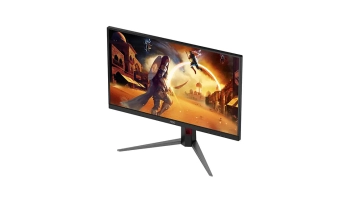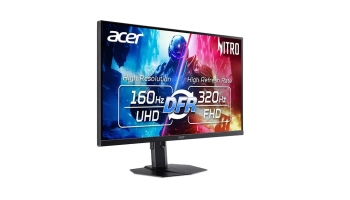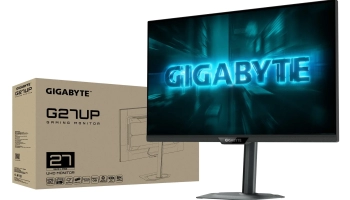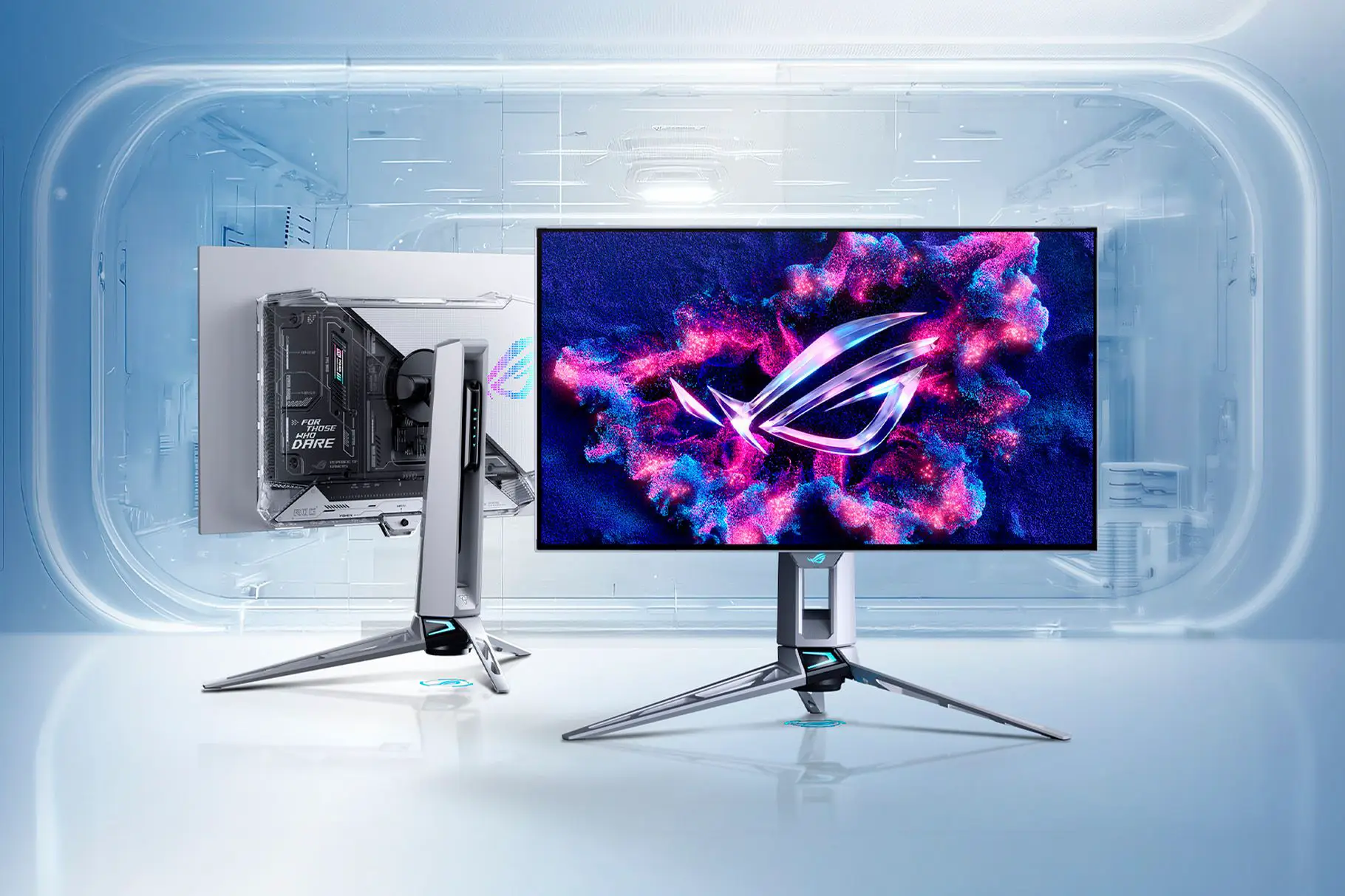
ASUS has officially announced availability for two gaming monitors that push OLED technology into new territory. The ROG Swift OLED PG27AQWP-W and ROG Strix OLED XG27AQWMG both feature LG Display’s fourth-generation Tandem OLED panels that promise brighter images, longer lifespan, and richer colors than their predecessors.
Traditional OLED gaming monitors use three light-emitting layers. LG Display’s new Primary RGB Tandem technology bumps that up to four layers working together, which delivers tangible benefits. According to ASUS you’re looking at 15% higher peak brightness, 25% wider color volume, and (perhaps most importantly for OLED skeptics) 60% longer lifespan compared to previous-generation WOLED panels.
Both monitors reach up to 1500 nits peak brightness in HDR mode and 335 nits in SDR, a substantial improvement over earlier WOLED displays. They’ve also earned VESA DisplayHDR 500 True Black certification – a step up from the True Black 400 rating common on competing QD-OLED panels.
| Specifications | ROG Swift OLED PG27AQWP-W | ROG Strix OLED XG27AQWMG |
|---|---|---|
| Screen Size | 26.5 inches (27-inch class) | 26.5 inches (27-inch class) |
| Resolution | 2560 x 1440 (QHD) | 2560 x 1440 (QHD) |
| Refresh Rate | 540Hz (native) / 720Hz (dual mode at 720p) | 280Hz |
| Response Time | 0.02ms (GtG) | 0.03ms (GtG) |
| Panel Type | 4th Gen Tandem WOLED | 4th Gen Tandem WOLED |
| Peak Brightness (SDR) | 335 nits | 335 nits |
| Peak Brightness (HDR) | 1500 nits | 1500 nits |
| Color Gamut | 99.5% DCI-P3 | 99.5% DCI-P3 |
| HDR Certification | DisplayHDR 500 True Black | DisplayHDR 500 True Black |
| Coating | TrueBlack Glossy | TrueBlack Glossy |
| DisplayPort | DisplayPort 2.1a UHBR20 (80Gbps) | DisplayPort 1.4 (DSC) |
| HDMI | HDMI 2.1 | HDMI 2.1 |
| USB Hub | Yes | Yes |
| Special Features | Dual mode, Neo Proximity Sensor, OLED Care Pro, tripod socket | Neo Proximity Sensor, OLED Care Pro, 30% smaller stand, tripod socket |
| MSRP | $1,099 | $599 |
| Availability | November 2025 | November-December 2025 |
The Flagship: ROG Swift OLED PG27AQWP-W
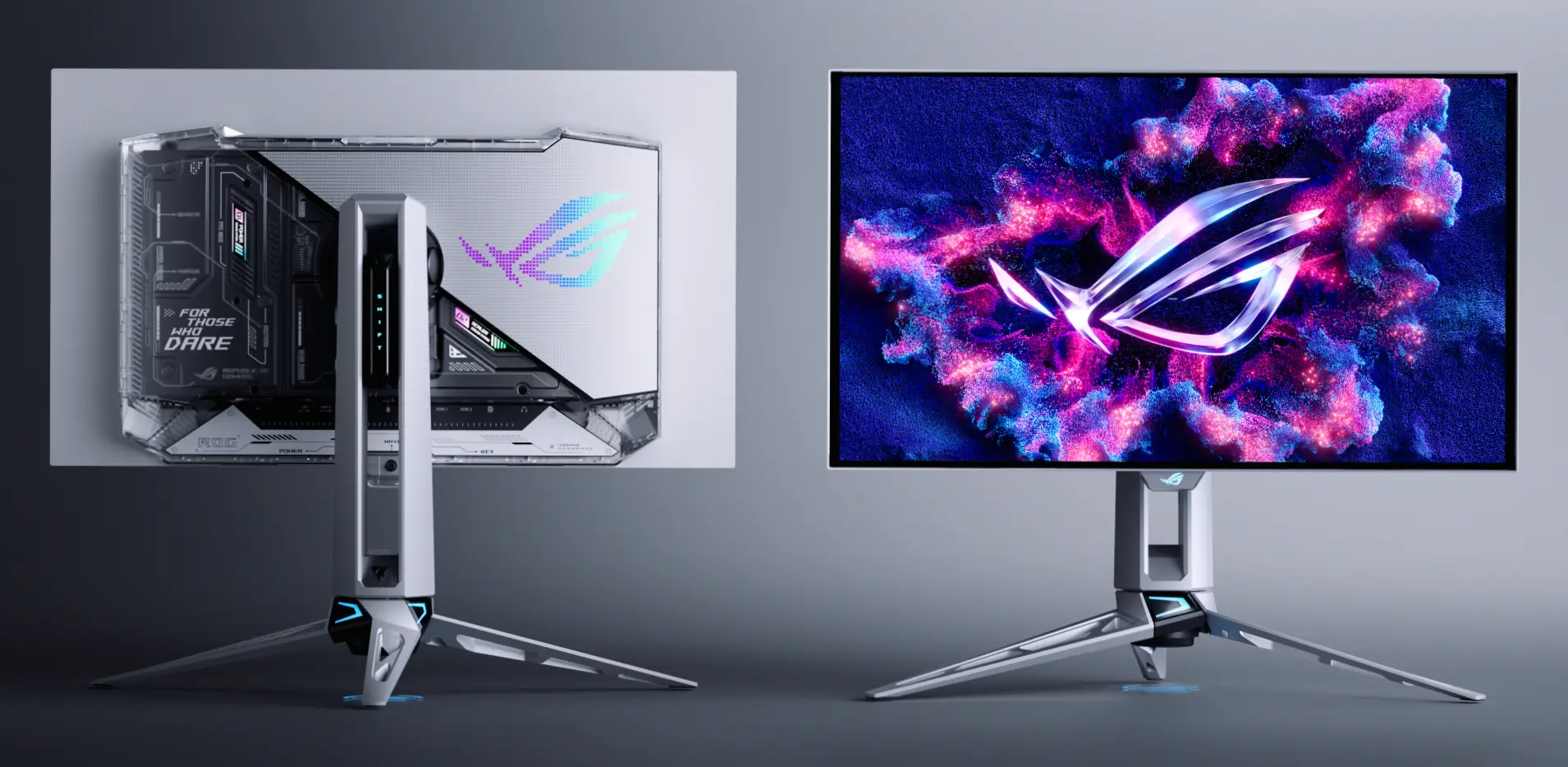
The PG27AQWP-W runs at a native 540Hz refresh rate at 1440p resolution, currently the fastest OLED panel on the market in 2025. Response time sits at 0.02ms gray-to-gray, which essentially means instant pixel transitions.
Additionally, the monitor includes a dual-mode feature that lets you switch to 720p at 720Hz via hotkey. This kind of resolution and refresh rate is hardly interesting for single-player gamers looking for immersive experiences, but could be attractive for esports players chasing every competitive advantage. Running games at 720Hz means each frame displays for just 1.39 milliseconds.
The PG27AQWP-W sports a white finish with translucent design elements and Aura Sync RGB lighting. Connectivity includes DisplayPort 2.1a with full UHBR20 support (80Gbps bandwidth) and HDMI 2.1. There’s also a tripod socket if you’re mounting cameras or microphones to your setup.
ASUS is pricing this flagship at $1,099 MSRP, with availability starting in November 2025. That puts it in premium territory, though it’s currently the only way to get 540Hz OLED performance.
The Value Option: ROG Strix OLED XG27AQWMG

Not everyone needs 540Hz or wants to spend four figures on a display. That’s where the Strix model comes in. The XG27AQWMG uses the same Tandem OLED technology but caps refresh rate at 280Hz with a slightly slower 0.03ms response time. For most gaming scenarios, you won’t notice the difference.
What you will notice is the $599 price tag. According to TFTCentral’s testing, the XG27AQWMG delivers nearly identical color accuracy and HDR performance to its pricier sibling, just without the extreme refresh rate or premium design flourishes.
The Strix features a more compact stand that’s 30% smaller than previous 27-inch XG series monitors. Connectivity includes DisplayPort 1.4 with DSC, HDMI 2.1, and a USB hub. Like the Swift, it includes ASUS’s Neo Proximity Sensor that automatically dims the display when you walk away, helping prevent burn-in.
TrueBlack Glossy: ASUS’s New Coating
Both monitors feature what ASUS calls TrueBlack Glossy coating, a zero-haze finish that’s different from the matte anti-glare found on many gaming monitors. The glossy approach preserves the deep blacks and sharp image quality that OLED are good at, while an anti-reflective layer reportedly reduces ambient reflections by 38% compared to first-generation glossy WOLED panels.
Glossy coatings divide opinion. Some users find them distracting in bright rooms, while others appreciate the superior contrast and color pop. For professional users, it’s usually matte all the way, but gaming may benefit.
How Do They Stack Up Against Competition?
LG launched its own Tandem OLED monitor, the UltraGear OLED 27GX700A, using the same underlying panel as the Strix. It runs at 280Hz with similar specifications but costs $849—substantially more than ASUS’s $599 asking price. LG uses a matte coating rather than glossy, which may appeal to users in bright environments, though it sacrifices some of that OLED contrast depth.
Gigabyte’s MO27Q28G also uses this Tandem OLED panel and initially aimed for a $499 price point, though that’s reportedly increased to $549. Still, that makes it the cheapest entry into Tandem OLED territory.
For those wondering about ASUS’s previous flagship, the ROG Swift PG27AQDP ran at 480Hz using a third-generation WOLED panel. While impressive when it launched, it lacked the brightness improvements and extended lifespan of these new Tandem OLED models. The PG27AQDP often starts around $999, making the new Swift with its higher refresh rate and better panel technology a logical step up at $1,099.
| Specification | ASUS Strix XG27AQWMG | LG 27GX700A | ASUS PG27AQDP (Previous Gen) |
|---|---|---|---|
| Panel Technology | 4th Gen Tandem WOLED | 4th Gen Tandem WOLED | 3rd Gen WOLED (MLA+) |
| Resolution | 2560 x 1440 | 2560 x 1440 | 2560 x 1440 |
| Refresh Rate | 280Hz | 280Hz | 480Hz |
| Response Time | 0.03ms | 0.03ms | 0.03ms |
| Peak Brightness (SDR) | 335 nits | 335 nits | ~275 nits |
| Peak Brightness (HDR) | 1500 nits | 1500 nits | 1300 nits |
| HDR Certification | DisplayHDR 500 True Black | DisplayHDR 500 True Black | DisplayHDR 400 True Black |
| Color Gamut | 99.5% DCI-P3 | 99.5% DCI-P3 | 99% DCI-P3 |
| Coating | TrueBlack Glossy (0% haze) | Matte anti-glare | Matte anti-glare |
| OLED Lifespan | 60% longer than 3rd Gen | 60% longer than 3rd Gen | Standard 3rd Gen |
| Subpixel Layout | Primary RGB | Primary RGB | RWBG |
| Text Clarity | Improved (better subpixel layout) | Improved (better subpixel layout) | Fair (RWBG fringing) |
| MSRP | $599 | $849 | $999 (typical) |
With ASUS, LG, and Gigabyte all launching Tandem OLED monitors within months of each other, we’re seeing the technology move from cutting-edge to competitive in record time. That’s good news for consumers—prices will likely continue dropping as production scales up and more brands enter the market.
For now, ASUS has positioned itself well with two distinct products: the ultra-premium Swift for those who want the absolute best, and the Strix for gamers who want Tandem OLED’s benefits without premium pricing. Whether that strategy pays off depends partly on how aggressively competitors like Gigabyte price their offerings.
If you’re not sold on Tandem OLED or the glossy coating, there are alternatives worth considering. The LG 27GX700A offers the same panel technology with a matte finish for better ambient light handling, though at a higher $849 price point.
QD-OLED displays like Samsung’s Odyssey series or various ASUS models offer excellent color saturation and are generally cheaper, but they cap out at 360-500Hz and use older panel technology without Tandem’s longevity improvements. They’re still great monitors, however.
For those interested in dual-mode functionality but wanting to avoid OLED, Mini LED monitors with Dynamic Frequency Resolution offer similar flexibility, though without OLED’s contrast and response time advantages.


